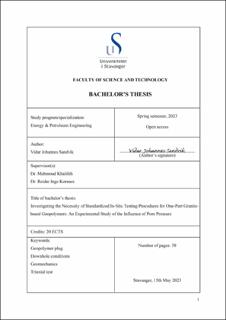| dc.description.abstract | Portland cement has been the primary binder used in well construction due to its availability, affordability, and favorable characteristics. However, alternative options are being explored due to well integrity challenges originating from the chemistry of Portland cement and its environmental impacts due to greenhouse gas emissions during its manufacturing. Geopolymers have emerged as a promising alternative material due to their favorable laboratory testing results and ability to meet most qualifications for barrier materials in NORSOK Standard D-010. As geopolymers move closer to commercialization, standardized testing protocols will be necessary.
In this project, the effect of pore pressure on the mechanical strength and elastic modulus of geopolymers has been researched using a triaxial setup. During this research, 12 geopolymer samples were prepared, where six were tested with pore pressure and the rest without. The tests were performed under three different conditions, where two tests were performed with and two without pore pressure at each condition.
The obtained results show that applying pore pressure impacts the geomechanical properties of the geopolymers. For the hydrostatic phase, the tests performed with pore pressure had linear and repeatable stress versus strain curves that did not change form during the hydrostatic loading phase. During this phase, improved repeatability was observed for the tests performed with pore pressure applied. The repeatability was improved for both the measured strains and the Bulk modulus. Furthermore, the tests performed at 120℃ with applied pore pressure were stronger and had even better repeatability than those performed at 90℃ with applied pore pressure.
In addition, it is worth noting that pore pressure impacts the deviatoric phase. The tests conducted with applied pore pressure exhibited greater repeatability in terms of both the mechanical strength and the shape of the axial stress versus strain curves. The results also suggest that the applied pore pressure may enhance the repeatability of Young’s modulus, although further experiments are required to draw a definitive conclusion. It should be noted, however, that pore pressure did not appear to affect Poisson’s ratio. | |
